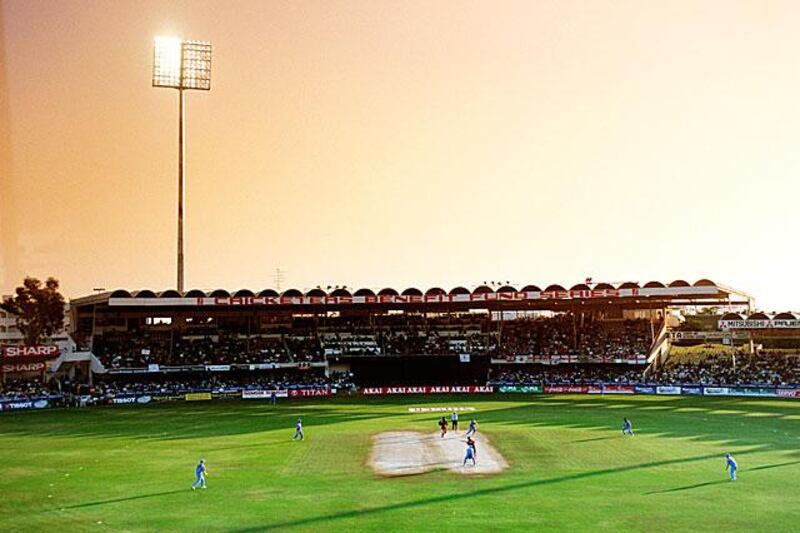If it was not for Hanif Mohammad, there might never have been international cricket in Sharjah. Hanif never played limited overs cricket, of course, the bread on which the legend of Sharjah was buttered. In fact, he was everything limited overs cricket is not.
His greatest innings - 337 against the West Indies in the 1957/58 series - was built over 16 hours, the sport's longest ever. It lasted more than two 50-over games and nearly five Twenty20s.
He was patient and time consuming, proof that sport can be gently, contemplatively unravelled, not always ripped open in a rush to catch a breathless, incomplete glimpse.
When he batted, it was an exercise in occupation of enemy territory, not a brief blitz into it. And yet without him, we must conclude, there might not have been the razzmatazz of Sharjah.
When Abdulrahman Bukhatir was studying in Karachi and falling in love with the game, his hero was Hanif. So when he subsequently returned to the Emirates, Bukhatir naturally patronised the game among the growing population of subcontinent expatriates in numerous, smaller ways until, in 1981, came the big moment.
For a couple of years he had been trying to find a way to pay tribute to Hanif. The plan was to arrange a benefit match, but it was not coming together until Haseeb Ahsan, the one-time Pakistan off-spinner and soon to be full-time administrator provocateur, was roped in. He found Asif Iqbal, who had recently retired from international cricket.
"Haseeb told me about Bukhatir in 1980 and his plans for Hanif," Iqbal recalled. "He said 'Why don't you get two teams together and you can get a benefit out of it as well'. So I met Bukhatir in London in the summer, then again in Sharjah, and he said 'Get an Indo-Pak team together and I'll put US$50,000 [Dh183,652] in as a benefit to you as well'."
Bukhatir took Iqbal to a vast plot of land, empty of life but full of sand. It was October. "Bring me two teams," Bukhatir told Iqbal, "and everything will be up and running for March."
Bukhatir was off by a month. On that land near the Sharjah Club, the Sharjah Cricket Association built its biggest ground (of eight). Grass was grown and an all-weather synthetic surface fixed on top of the usual cement turf. Scaffolding was set up for spectators.
They were not expecting many.
Iqbal used his network to pull in, essentially, the entire first teams of India and Pakistan: the Sunil Gavaskar XI and the Javed Miandad XI. On April 3, 1981 everything was ready. Nearly 8,000 came, surprising and worrying organisers, who were not sure the scaffolding would hold them all, to watch a contest unbefitting of the occasion. The Indians scored 139 in 45 overs and the Pakistanis chased it down comfortably. The match was hardly the tale.
"It was India-Pakistan, and that is what sold the concept completely," Iqbal said.
Smitten, Iqbal suggested to Bukhatir immediately after to make it an annual match. Bukhatir agreed. Three years later came the official birth of Sharjah as an international venue when Pakistan, India and Sri Lanka played the first Asia Cup there; the opener between Pakistan and Sri Lanka on April 6 was the first officially recognised one-day international at the Sharjah Cricket Association stadium.
And so followed the rest, nearly 18 years of international cricket in all, but probably 13 as an annual, compulsive ritual. October came and with it came Sharjah, India and Pakistan, labourers and film and television stars, an entire scene.
To the world outside the subcontinent it was lost. Wisden did not even record that Asia Cup in their annual, despite it being a recognised tournament. They did not acknowledge it until Australia and England visited for the Rothman's Trophy in March 1985. But within the subcontinent it was a different beast, representing much more than just a game. Success had much to do with it. Pakistan lorded over it, winning 13 out of 26 tournaments. And for all the inferiority complex Miandad's last-ball six imposed on India, they still won six tournaments (Sri Lanka won four to round off what amounted to a regional lease on the stadium).
The rest of the world constituted an irregular but worthy sideshow. Though not imprinted on the mind as vividly, the West Indies had good times in Sharjah, winning four tournaments. Instead, easier to recall are Courtney Walsh's arrow-straight spell of five for one against Sri Lanka in the 1986/87 Champions Trophy and Brian Lara's 153 that did not just win the 1993/94 Champions Trophy, but snapped the monopoly Pakistan had established between 1989 and 1994 in winning five out of six tournaments.
The freakiest feat remains England's Champions Trophy triumph under Adam Hollioake in 1997/98, their only ODI tournament win during the entire 1990s.
That tournament ultimately came to embody the corruption that brought Sharjah down. Like many players, the venue was implicated but never emphatically convicted. How is it a venue's fault that matches came to be fixed there? Corruption knew no geography then.
Now it is back. On November 3 it hosts Pakistan and Sri Lanka for the final Test of the series and then again on November 20 for a one-day international. It has been give a face lift; dressing rooms have been relocated, a new area for match officials carved out. Seating is being revamped and canopies put in. It cannot hope to match the bling stadiums of Abu Dhabi and Dubai. But we will be old and grey before those venues grow the soul Sharjah has.
Follow
The National Sport
on
[ @SprtNationalUAE ]
& Osman Samiuddin on
[ @OsmanSamiuddin ]





